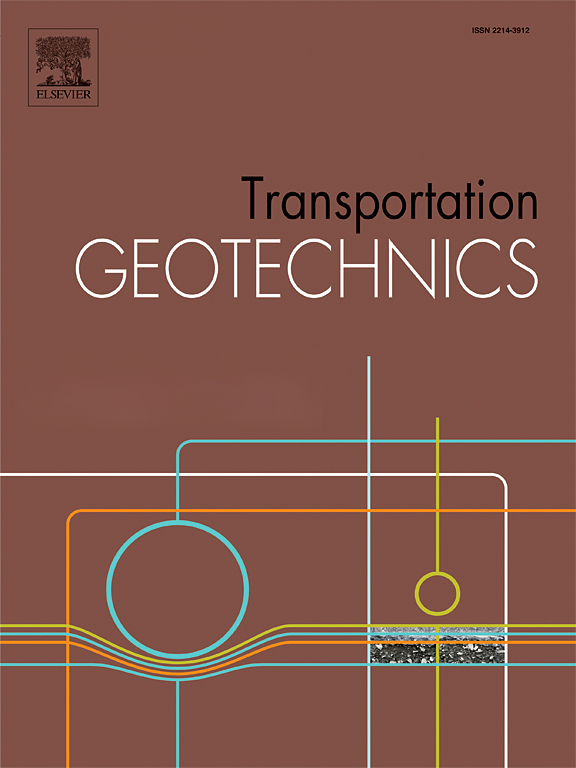利用深层板对桥梁引桥的沉降和破坏模式进行离心试验研究
IF 4.9
2区 工程技术
Q1 ENGINEERING, CIVIL
引用次数: 0
摘要
桥端凸起问题是桥梁和引桥失效的一个关键问题。为了研究桥梁引桥的沉降及其诱发的破坏,利用环形模型箱进行了一系列新型离心机试验。试验中模拟了一种新的桥端凸起缓解方法,即深层板。这项研究从标准交通荷载条件下结构与土壤相互作用的角度,分析了路面刚度、土壤模量和荷载循环对变形的决定性作用。试验结果表明,当使用深层板时,桥梁引桥的变形遵循指数衰减模式,在大约一个板长后最终趋于稳定。此外,上桥和下桥表现出不同的损坏模式,即上桥的车轮碰撞造成桥梁损坏,下桥的车轮撞击造成路面损坏。路面的损坏区域约为车轮宽度的 1.7 倍,桥梁的损坏区域约为车轮宽度的 2.6 倍。最后,考虑到路面刚度、路基土模量和荷载循环的影响,提出了桥梁引桥变形的预测模型。变形与三个归一化变量之间的关系符合二次多项式函数。本文章由计算机程序翻译,如有差异,请以英文原文为准。
Centrifuge tests study on settlement and damage modes of bridge approaches using deep-seated slab
The issue of bridge end bumps is a critical concern in the failure of bridge and bridge approaches. A series of novel centrifuge tests utilizing a ring model box were conducted to investigate settlement and its induced damages at the bridge approach. A new mitigation method, the deep-seated slab, for bridge end bumps was modeled in the test. This study analyzed the decisive role of pavement stiffness, soil modulus, and load cycles on deformation from the perspective of structure-soil interaction under standard traffic load conditions. The test results show that when deep-seated slabs are used, the deformation of the bridge approach follows an exponential decay pattern, eventually stabilizing after approximately one slab length. Furthermore, the upper and lower bridges exhibit distinct damage modes, i.e., the bridge damage by wheel collision at the upper bridge and the pavement damage by wheel impact at the lower bridge. The damage zone on the pavement is approximately 1.7 times the wheel width and the damage zone on the bridge 2.6 times. Finally, a predictive model for the deformation of bridge approaches was proposed, considering the effect of pavement stiffness, subgrade soil modulus, and load cycles. The relationship between the deformation and the three normalized variables conforms to the quadratic polynomial function.
求助全文
通过发布文献求助,成功后即可免费获取论文全文。
去求助
来源期刊

Transportation Geotechnics
Social Sciences-Transportation
CiteScore
8.10
自引率
11.30%
发文量
194
审稿时长
51 days
期刊介绍:
Transportation Geotechnics is a journal dedicated to publishing high-quality, theoretical, and applied papers that cover all facets of geotechnics for transportation infrastructure such as roads, highways, railways, underground railways, airfields, and waterways. The journal places a special emphasis on case studies that present original work relevant to the sustainable construction of transportation infrastructure. The scope of topics it addresses includes the geotechnical properties of geomaterials for sustainable and rational design and construction, the behavior of compacted and stabilized geomaterials, the use of geosynthetics and reinforcement in constructed layers and interlayers, ground improvement and slope stability for transportation infrastructures, compaction technology and management, maintenance technology, the impact of climate, embankments for highways and high-speed trains, transition zones, dredging, underwater geotechnics for infrastructure purposes, and the modeling of multi-layered structures and supporting ground under dynamic and repeated loads.
 求助内容:
求助内容: 应助结果提醒方式:
应助结果提醒方式:


